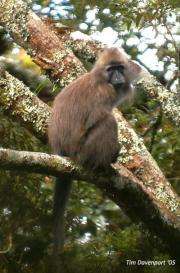Africa's rarest monkey had an intriguing sexual past, DNA study confirms

The most extensive DNA study to-date of Africa's rarest monkey reveals that the species had an intriguing sexual past. Of the last two remaining populations of the recently discovered kipunji, one population shows evidence of past mating with baboons while the other does not, says a new study in Biology Letters. The results may help to set conservation priorities for this critically endangered species, researchers say.
A shy tree-dwelling monkey with a black face and long brown fur, the kipunji (key-POON-jee) was unknown to science until 2003, when it was discovered in a remote region of southern Tanzania. Until recently, little was known about its biology except what scientists could glean from observations and a single specimen found in a farmer's trap. The first analyses revealed that kipunji represented an entirely new genus of primate, Rungwecebus. Now, thanks to additional DNA samples collected from dung and tissue — the most extensive genetic data to date — scientists have a more complete picture of the genetic makeup of this monkey.
The kipunji is found in two tiny forest fragments totaling less than 7 square miles, researchers explained. Of the last two remaining populations, one is in Tanzania's Southern Highlands, and the other lies 250 miles away in a mountain range called the Udzungwas. Armed with six dung samples from the Udzungwas - the first ever genetic material from this population - and two additional tissue samples from the Southern Highlands, the researchers were able to reconstruct the genetic relationships between these populations and kipunji's closest kin.
Confirming other reports, the Southern Highlands population contained bits of DNA that are similar to baboons. This suggests that the two species interbred at some point after they diverged, researchers explained. "Way back in time in the evolutionary history of this population there was at least one event where there was some cross-fertilization with a baboon," said study author Tim Davenport of the Wildlife Conservation Society.
In contrast, the researchers discovered that the Udzungwa population showed no traces of baboon DNA. "We thought the DNA from the second population would match the first one, but instead we got something quite different," said first author Trina Roberts of the National Evolutionary Synthesis Center in Durham, NC.
Mating across the species barrier isn't unheard of in the animal kingdom. "We usually think of species' genomes as being contained and not sharing with each other, but sometimes one species picks up genetic material from another through interbreeding," said Roberts. "It's as if the genomes are a little leaky."
The findings help to settle a debate over kipunji's status as a new genus of primate. "They're still separate taxa — they're not baboons, they're still kipunji," said co-author Bill Stanley of the Field Museum of Natural History in Chicago. "But there's a little bit of baboon DNA that shows up when you analyze their DNA."
Their results may also help to set conservation priorities for this critically endangered monkey. Much of the kipunji's remaining habitat is threatened by deforestation for farming and other uses, the researchers explained. "There's a lot of pressure on the forest for natural resources - food, medicine, fuel, and building materials," said Davenport. "Part of the challenge we have is making sure the forest isn't degraded any further."
Census data indicate there are just over 1,100 individuals left in the wild, said Davenport. Of these, roughly 1,000 live in the Southern Highlands, and 100 remain in the Udzungwas. Both populations may require habitat protection if we are to preserve the genetic diversity of the species, researchers said.
"Udzungwa is a tiny population," said Roberts. "What we've shown is that it is substantially different from the first population. We may not be able to resurrect it by simply transplanting kipunji from one population to the other," Roberts said.
"If we were to lose it we might in fact lose the true kipunji genome forever," she added.
"Does the baboon DNA help to explain why there are differences in number between the two populations, or is just a remnant of evolutionary history?" asked Davenport. "It's too early to say, but it's something we're looking at."
"We have two separate populations that are slightly genetically different, so until we learn more it is extremely important that we maintain both of them," Davenport said. "It might be that those genetic differences have an impact on their survival in the future."
More information: Roberts, T. E., T. Davenport, et al. (2009). "The biogeography of introgression in the critically endangered African monkey Rungwecebus kipunji." Biology Letters.
Source: National Evolutionary Synthesis Center


















